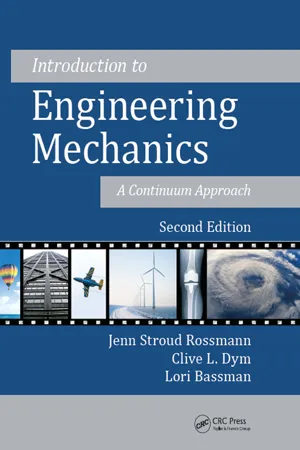Technology & Engineering
Deflection due to Bending
Deflection due to bending refers to the deformation of a structural element when subjected to bending moments. When a beam or any other structural member is loaded, it experiences bending stresses that cause it to deflect. The amount of deflection is influenced by the material properties, geometry, and the magnitude of the applied loads.
Written by Perlego with AI-assistance
Related key terms
Related key terms
1 of 4
Related key terms
1 of 3
3 Key excerpts on "Deflection due to Bending"
- eBook - ePub
Mechanical Engineering Design
Third Edition
- Ansel C. Ugural(Author)
- 2020(Publication Date)
- CRC Press(Publisher)
4 Deflection and Impact4.1 Introduction
Strength and stiffness are considerations of basic importance to the engineer. The stress level is frequently used as a measure of strength. Stress in members under various loads was discussed in Chapter 3 . We now turn to deflection, the analysis of which is as important as that of stress. Moreover, deflections must be considered in the design of statically indeterminate systems, although we are interested only in the forces or stresses.Stiffness relates to the ability of a part to resist deflection or deformation. Elastic deflection or stiffness, rather than stress, is frequently the controlling factor in the design of a member. The deflection, for example, may have to be kept within limits so that certain clearances between components are maintained. Structures such as machine frames must be extremely rigid to maintain manufacturing accuracy. Most components may require great stiffness to eliminate vibration problems. We begin by developing basic expressions relative to deflection and stiffness of variously loaded members using the equilibrium approaches. The integration, superposition, and moment-area methods are discussed. Then, the impact or shock loading and bending of plates are treated. The theorems based upon work–energy concepts, classic methods, and finite element analysis (FEA) for determining the displacement on members are considered in the chapters to follow.4.1.1 Comparison of Various Deflection Methods
When one approach is preferred over another, the advantages of each technique may be briefly summarized as follows. The governing differential equations for beams on integration give the solution for deflection in a problem. However, it is best to limit their application to prismatic beams, otherwise, considerable complexities arise. In practice, the deflection of members subjected to several loading conditions, or complicated ones, is often synthesized from simpler loads, using the principle of superposition. - eBook - ePub
- B. Raghu Kumar(Author)
- 2022(Publication Date)
- CRC Press(Publisher)
CHAPTER 7 Deflection in Beams 7.1 INTRODUCTION In the preceding chapters we discussed about the stresses that are induced in the beams. This aspect may be used in design of beams from strength point of view. In this chapter we will be concerned about another aspect in the design of beams namely, deformation or the deflection of the beam. Since in some cases the design specification of a beam will generally includes the maximum possible deflection in association with or without maximum permissible stresses. For example, the building codes specify upper limit on deflections as well as stresses because the large deflections are associated with poor appearance and with too much flexibility. In addition knowledge of the deflection is required to analyze the statically indeterminate structures which will be dealt in the next chapter. A number of analytical methods are available to find the the deflection of beams. We consider three methods in this text. 7.2 DIFFERENTIAL EQUATION FOR DEFLECTION OF BEAMS When a beam is loaded the initially straight longitudinal axis beam deformed into curve called the differential curve of the beam. Double integration method uses a second order differential equation of deflection curve for a beam. To obtain the general equation of a beam, let us consider a cantilever beam loaded at free end as shown in the Fig. 7.1. The xy plane is considered as plane of bending. The deflection y at any point m l on beam at a distance of x from fixed end (origin) is the displacement of the point in the y – direction. Generally downward deflection is positive and upward deflection is negative. The y is expressed as a function of x, we have the equation of deflection curve. The angle of rotation θ of the beam at any point ml is the angle between the x – axis and the tangent to the deflection curve - eBook - ePub
Introduction to Engineering Mechanics
A Continuum Approach, Second Edition
- Jenn Stroud Rossmann, Clive L. Dym, Lori Bassman(Authors)
- 2015(Publication Date)
- CRC Press(Publisher)
9Beam Deflections
Knowing the accurate deflection of a beam under certain loading conditions is of interest to us as designers. In some designs, for example, when we design for stiffness, we will be seeking to minimize deflection (strain). Floorboards, roof supports, and bookshelves are some examples of beams whose deflections are ideally minimized. In other cases, a functional design may rely on the deflections of beams; examples of this include diving boards, leaf springs, and atomic force microscope cantilevers. Both situations require that we be able to predict the deflection behavior of a beam under loading (and more prudently than is suggested in Figure 9.1 ).9.1 Governing Equation
We will model the deflected shape of a beam in terms of the vertical movement of the beam’s neutral axis. Once again, we will make use of the premise that during bending, plane cross-sections normal to this axis through a beam remain plane. For simplicity, we will first consider bending only about one of the principal axes of the cross-section. All of this should sound familiar from the previous section’s explanation of pure bending, but now we will include an added generality: we will discuss variation of the radius of curvature ρ of the neutral axis along the span (x).In Figure 9.2 , we see a segment of a beam with a greatly exaggerated z-direction deflection w, measured from the x-axis. We note that the slope of the beam’s neutral axis at point A is dw/dx = −tan θ. Since we are assuming small deformations, we say tan θ ≈ θ in radians. The change in slope between points A and B, which were originally dx apart on the horizontal beam axis, is −dθ. The curvature of the beam, or the rate of change of the slope with respect to x, is
or,dd x(=)d wd xdd x(,− θ)(9.1) = −d 2wdx 2dθ.d x(9.2) In Figure 9.2 , we remind ourselves that the neutral axis can be thought of as a segment of a very large circle with radius ρ. The angle dθ between A (deflection w) and B (deflection w + dw) is the change in θ from x to x + dx
Index pages curate the most relevant extracts from our library of academic textbooks. They’ve been created using an in-house natural language model (NLM), each adding context and meaning to key research topics.
Explore more topic indexes
Explore more topic indexes
1 of 6
Explore more topic indexes
1 of 4


